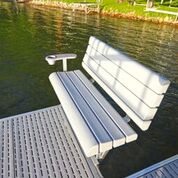Jun 26, 2017
How to Clean wood decking
How do you clean wood decking and restore the finish to look natural again – without damaging the environment? We all know that we need to avoid introducing pollutants into the water. This includes soaps and most other commercially available cleaning products. So what are your options?
According to NADRA (North American Deck and Railing Association) we first need to understand what mold is.
“Mold is the common term used to describe a growth on the surface of organic matter, caused by fungi, especially in the presence of dampness. Mold is Nature’s way of recycling organic matter and is often used interchangeably with the word mildew.
Under a microscope, mold has an octopus-like structure. Its legs attach to a surface in a web-like manner. Once a mold has successfully colonized, it turns a dark color and releases thousands of new spores. It usually takes about 3-4 months for untreated, fresh wood to start to turn white. After that, the dreaded gray you see on fences, decks and docks starts.
What makes mold grow?
Molds need three things to grow:
- Food,
- Water and
- Temperate weather.
Where does the “food” come from?
How about the dirt your family and pets put on the decking after walking across the lawn and beach? Then there’s the “diet leftovers” from the seagulls and geese.
How about the suntan oils and lotions people brought to the deck.
Finally, don’t forget about the “waste” from the seagulls and geese? You see it every day. Do you know what’ s lurking in that waste? OK – let’s move on to the next item.
Where does the water come from?
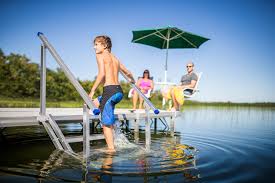
For mold to spread it needs water
The water is a combination of rain, humidity and the water from your feet, your pets feet and the equipment you used that is now sitting on the deck panels.
Temperate weather?
Remember that sunshine and mild temperatures you crave so much? Mold loves it too. In fact, if it’s too hot the mold simply goes dormant and waits for better conditions to start the process all over again.
What happens when all these things come together?
When the spores find a favorable environment, they will germinate. What constitutes a favorable environment is different for each species. The spores settle out of the air. As a result they will be more prevalent on horizontal surfaces (like your dock boards). The mold does not migrate, but rather it establishes colonies and releases even more spores.
First Step to clean wood decking
Make a distinction about what type of wood decking you have. Why is this important? Wood is Wood – Right? Wrong!
Some “treated woods” may contain toxins which are harmful to the environment and require a different approach to cleaning. Most experts would prefer to have nothing entering surface waters other than clean rain water. At the same time we also need to be able to keep our docks clean so they are safe and sanitary to walk on. To avoid fines and protect the water, the DNR requires bio-degradable solutions for cleaning, if used at all.
Natural, untreated wood or Pressure Treated?
Which wood do you have? This is important because treated wood may contain toxins which can harm fish and harm the environment. NEVER clean treated wood over water.
Do you have Natural, untreated wood (usually cedar, in some cases, pine) – OR – Pressure Treated wood?
If unsure what you have, there is a simple way to find out. Look UNDER the decking and see if it is a natural wood color (a very light or natural wood color). It may also be slightly gray. but has no “green colors” on it.
It has a “green tint” to it? A green color indicates that it is pressure treated. Be sure to check several panels to be sure. If the sunlight has not gotten to the bottom of the decking, treated wood will retain a “green” look for a long time. Do not attempt to clean this decking over the water.
Another way is to call the dealer to see what they used.
Untreated, Unpainted, Unstained Cedar or Pine?
To clean untreated, unpainted or stained cedar or pine decking is always a challenge but there are a number of ways to do it.
Among the choices for untreated wood are:
- Use a pressure washer (the most popular way)
- Hand scrub the decking with a commercially available biodegradable cleaner like “OxiClean” (not very effective from the author’s experience)
Using a Pressure washer
A word of caution – In all cases the use of safety gloves, face masks or eye protection is highly recommended to clean wood decking.
The use of a pressure washer is probably the most popular way to clean wood. However, it must be done very carefully due to the “grain” of the wood.
Too much pressure or spraying “against the grain” can cause serious damage to the decking and raise the wood grain. Wood grains that are raised will look like “splinters or fuzz” on the surface of the wood..
- Always spray in the direction of the grain – never “against the grain.” This can be hard to do since many people are not familiar with how the natural wood grain will look in its original state. It also depends on the way the boards are mounted on the dock. Keep in mind that even though one board has the grain going “left to right”, the next board may be “right to left”.
- Never allow the pressure head to get closer than 6-12 inches from the wood. This depends on the hardness of the wood, the pressure of the washer and the type of spray tip you are using. The less pressure at the spray head, generally the closer you can get to the surface. It is also recommended that a 20-40 degree “fan tip” be used. This way the water pressure is not too intense for the wood grain if you make a mistake in the grain direction.

Pressure Washing to clean wood decking
Actual experience
Note – The author used a 1600# pressure washer, with a turbo tip (this sprays in a rotating circular motion) to clean wood pine decking. After raising the grain several times following the previous method explained above, The author found that it was faster and safer to clean the wood by spraying across the boards no matter which way the grain was going.
Looking at the picture above (they obviously had gone lengthwise down the boards). I went back and forth cross ways across 4-8 boards in a stroke. The tip I used is very aggressive and yet it never raised the grain on a deck which was at least 20 years old. You will need to experiment on your own wood to find the “sweet spot” between having too narrow a spray pattern and getting the right speed so it does not take all day. This approach was very effective and I did not need chemicals nor did I “raise the grain” unless I stayed too long in one spot.
Hand scrubbing
The use of a hand brush and a commercially available product like “OxiClean” is a safer way to wash the decking. “OxiClean” breaks down to oxygen, water and soda ash so it won’t harm the environment. Be sure to rinse the decking with clear water after the cleaning process.
If the product you choose has oxalic acid (very corrosive) or chlorine bleach we strongly recommend that you do not use it because it is not bio-degradable. As an extra precaution check the label of any product you plan to use to see if it contains harmful ingredients such as hypochlorite bleach.
Oxygen bleaches can be irritating to the skin and harmful to your eyes and lungs
NEVER use chlorine bleach as it is harmful to your skin AND the environment and could get you a major fine from the DNR.
Pressure Treated Wood
Cleaning pressure treated decking gives you fewer options – actually ONE option. Oxidizing agents, even the humble sodium percarbonate, can react with some types of pressure treated wood to release chromium and arsenic into the environment. These chemicals are toxic to people and aquatic life at even fairly low concentrations. Avoid the use of ANY of these products and NEVER clean this type of decking over the water with any chemicals.
So what can you use? Clean water and good old fashioned elbow grease is the recommended method.
You have a major investment in your dock – clean the wood wisely.
REMEMBER
Pier & Waterfront Solutions (PWS) specializes in all ShoreMaster accessories for docks and lifts. PWS is located in the center of Door County at 7325 St Hwy 57, south of Sturgeon Bay at the intersection of Idlewild Road. Our staff looks forward to serving all of your waterfront needs.
Found this article helpful? Go to “NEWS” on any page of our website for a complete list of articles meant to keep you informed on the latest product information and maintenance issues. Check out our “older entries” also.
The wide variety of articles on dock and boat lifts issues will answer many of your questions. PWS believes that an informed consumer makes better decisions.
Call Jerry at 920-493-4404 or Email Jerry@wisconsinpws.com for more information.
. Coming Soon – “The PWS Store” on our website.
May 19, 2020
The Best Boat Dock Decking in Door County
Boat dock decking is no longer a simple piece of wood laid on other pieces of wood. There are many types of materials used on piers and boat docks today.
Today’s options include open-deck plastic, solid plastic boards, aluminum, wood, and various composites.
What’s the most popular decking used today, and why?
Today, wise shoppers choose plastic with the open-deck configuration.
Why?
It’s simple. The best type of decking is a plastic deck. Today’s plastic holds it’s original color (within 3%). It also keeps it’s shape better. Plastics need less maintenance than any of the other types of decking.
Plastic decking requires no staining or painting. The surface does not flake or wear-off, nor does it lose its color with exposure to the UV rays.
Open-decking helps resist the growth of mold and mildew far better than wood or even another plastic deck. Plastic stays cool in the summer, repels rain and dries quickly. About 90% of the moisture runs off immediately while the rest simply evaporates.
What about other types of plastic boat dock decking?
If you are referring to the wood and resin-impregnated boards, over time, the wood fibers swell. The moisture can attract mold and mildew.
How about recycled plastic boards with no fiber in it?
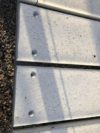
Typical Plank decking
The recycled boards come with their unique problems.
If stored in shaded areas, HDPE plastic boards cannot escape the mold/mildew cycle. See how the mold/mildew cycle develops HERE.
What’s the most important thing about decking?
Recycled decking is an extruded board. That means, when cresting waves hit the bottom of the dock, there is no release for the energy waves produce. The bolted-down boards keep the decking from washing away. But this creates a virtual “solid” surface for the wave’s energy to push against. The frame structure must take all the energy from the wave.
How can you prove this?
Look at a dock that flipped over during a storm. You will notice that the legs bent in the direction that the storm originated.
Solid boards with a 1/2″ gap every 6″ does not relieve the pressure from the waves.
The result is the upward pressure from the waves lifted the pier high enough for it to move sideways. The legs were no longer vertical. They came down at an angle, and the legs bent. The continuing pressure from the waves then pushed the dock over.
Plastic is plastic – isn’t it?
Yes, they are all oil derivatives. But, there are many types of plastic made today. Some are super hard and act as “bearing surfaces,” while others are very pliable.
In general, plastics will outlive us. The shape and surface area of the plastic makes a big difference when it comes to decking.
How do you relieve the upward energy?
The only way to relieve the pressure on the boat dock decking is to provide enough open areas for the wave energy to pass through. 42% open area is the standard today.
At this percentage, almost one-half of the wave energy passes through the decking. The wave is less likely to lift the dock. Yet the decking is strong enough to walk on.
If you combine the most massive steel frame in Door County along with an open deck,
you get the PWS 3-Season Pier.
Don’t Forget – Considering rip-rap for your shoreline? PWS is the place to contact!
Where is Pier & Waterfront Solutions?
Located at 7325 St. Hwy 57, it’s 3 miles south of Sturgeon Bay, and 1 mile past the intersection of Cty MM (heading north). Look on the right side, one mile north, at the next intersection (Idlewild Road and Hwy 57).
ARE WE OPEN?
During this time of uncertainty, Pier & Waterfront Solutions is staying “open.” We have implemented measures to ensure the safety of our employees and visitors. At the same time, we are working to maintain the trusted service that you have come to expect.
We are implementing these precautionary measures:
1. Conducting as much business as possible by email, text, or phone.
2. Site visits will continue but with limited in-person meetings. When in-person contacts are necessary, we will follow “social distancing” guidelines.
3. Our display yard is always open for you to examine at your leisure. All displays have a numbered, red tag on them. If you want more information or pricing, please reference that number.
4. Some employees are working remotely, but they are always available by phone.
5. Any employee exhibiting symptoms or illness is sent home.
6. We continue to provide estimates and invoices by email to make the process paperless and faster.
7. Crew starting times are being staggered to limit social interactions.
8. We keep the same crews together to limit cross interactions.
With these measures, we hope everyone will stay safe, and we will be back to normal operations soon.
What can YOU do to help us?
1. Please conduct as much business as possible via emails, messaging, and emails. This step protects everyone involved.
2. When you see our crews installing equipment, please practice “social distancing.”
So, YES – WE ARE OPEN!
Thank you for allowing us to work with you.
Please call, message, or email us with any questions.
Let’s all stay safe!
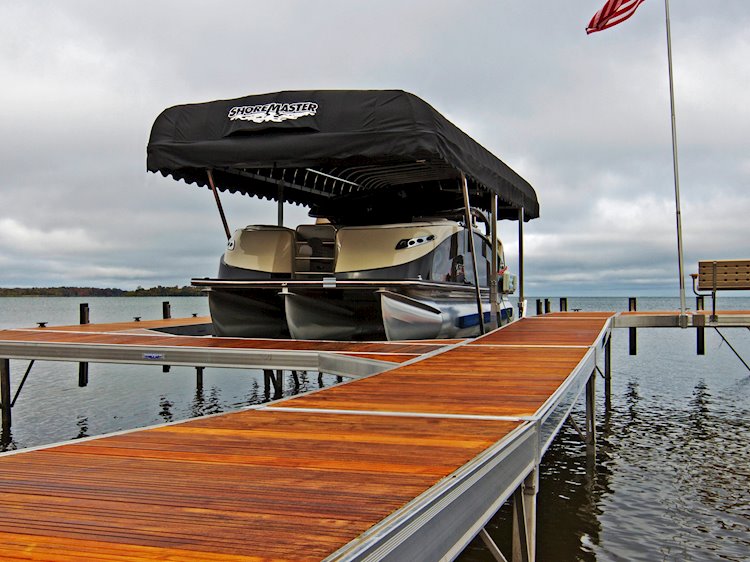
Jan 22, 2019
DOCK DECKING
Dock decking is a critical choice. With all the decking choices – it’s the most important choice you make.
Frames for docks were covered in Part 1 of this series. Part 2 will cover the many choices of decking you have.
WOOD DECKING
Wood decking was the first and only choice for decking. It required yearly cleaning. As simple as cleaning a deck may sound, it takes time each year.
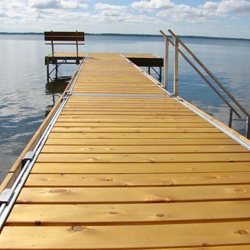
Cedar Wood Decking from ShoreMaster
The costs and inconvenience mount up.
In addition, a wood deck gets uncomfortably hot on sunny days. It also traps the dirt on its flat surface. This dirt needs to be washed off to prevent mold from forming. People started to look for other choices.
Then, along came a better choice!
ALUMINUM DOCK DECKING
Aluminum decking cuts down on maintenance. It solves the problem of painting or staining and sealing the wood. It only requires minimal washing to keep its appearance. No pressure washing or cleaners needed.
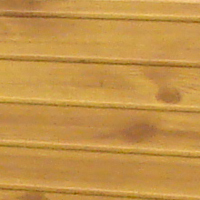
Aluminum Decking by ShoreMaster- Natural Woodgrain
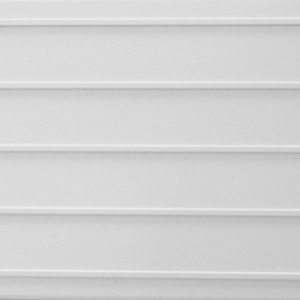
Aluminum Decking by ShoreMaster – White
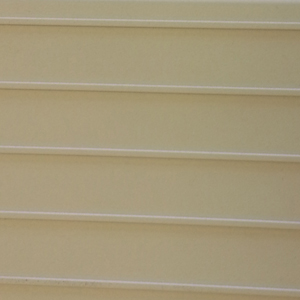
Tan Aluminum Decking by ShoreMaster
Plus, it does not get hot in the prolonged heat of the summer. The heat rapidly dissipates, so it stays cool to the touch.
There are many colors, and they look great.
Are there problems with aluminum?
Despite the advantages, aluminum does make noise when walked on. This issue is corrected by applying a cushion tape to the top of the frame.
Additionally, like wood, it comes in a “board” form. Why is that important?
PLASTIC DECKING
Initially, plastic decking came in a board form. The board was bolted to the frame so it would not wash away. This worked great except the plastic shrinks and swells in the weather. It also gets dirty from rain and sand.
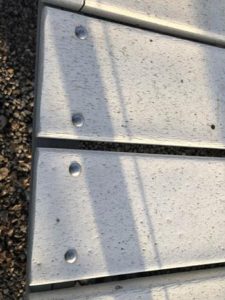
Typical Plastic boards
Most importantly, when the waves reached the decking, the 1/2″ opening between the boards was too small to relieve the pressure. This caused some docks (even heavy steel docks) to flip over.
People also mixed it with wood fibers which swelled over time. Still not a solution. Yet, plastic was a great idea, just not in a board form.
So what is the answer?
Back to plastic again
But not just any plastic. Flow-Through decking from ShoreMaster turned out to be the solution.
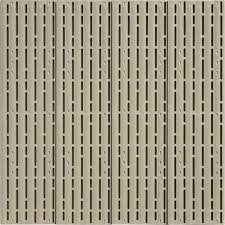
Glacier Flow Through Plastic Decking
There are many reasons that plastic Flow-Through decking is the best choice including:
• It’s lightweight;
• Available in many colors and patterns;
• Eliminates the need to clean the decking;
• Can be mounted to the frame with a breakaway clip (recommended) or screwed down);
• It’s cool in the summer heat; and
• Most importantly, it has a 42% open surface which means 42% less pressure.
The open surface allows the water to pass through the decking. These openings relieve the pressure on the dock when a wave hits it. Solid boards do not do this.
In addition to eliminating the pressure of the water, it “self-drains” due to its curved surface. The decking does not allow moisture buildup on the panels. You have now removed one of (3) ingredients for mold and mildew to form. See related article: https://wisconsinpws.com/cleaning-wood-decking/
In conclusion, if you want the BEST decking for your money – look for Flow-Through decking from ShoreMaster at PIER & WATERFRONT SOLUTIONS.
For more information about additional types of decking follow this link: https://wisconsinpws.com/best-dock-decking/
Where can you find Flow Through decking?
At Pier and Waterfront Solutions, of course.
Publication dates:
Part 1 – What does a Dock cost?
2 – What type of decking is available?
3 – Which dock configuration should I choose?
Need Help Planning a Dock System For Your Home or Cottage?
Do you have a friend that may be interested in this information? Please share a link to this page with them.
PWS is located at 7325 St. Hwy 57. That’s 1 mile North of County MM (Hwy 42) and 3 miles South of Sturgeon Bay at the Idlewild Road intersection.
Our staff is here year-round to assist you.
May 1, 2018
Decking for your dock is a critical choice
With all the materials available today for your dock – your decking choice is the most important decision you will make.

Cleaning wood decking
At one time, cedar or treated wood were your only choices. It wasn’t long before people realized the
maintenance for a wood deck took time away from enjoying their summer.
As simple as cleaning a deck may sound, it takes time each year. Even painted, or stained and sealed wood requires maintenance. The costs and inconvenience mount up quickly.
In addition, a wood deck gets uncomfortably hot on sunny days. It also traps the dirt on its flat surface. This dirt needs to be washed off to prevent mold from forming.
Then, along came a better choice!

ShoreMaster Aluminum Decking
Aluminum
Aluminum cuts down the maintenance considerably. It solves the problem of painting or staining and sealing the wood. It only requires minimal washing to keep its appearance. No pressure washing or cleaners needed.
Plus, it does not get hot in the prolonged heat of the summer. It dissipates the heat quickly.
Are there problems with aluminum?
Despite those advantages, aluminum does make noise when walked on. You can correct this issue by applying a custom tape to the frame.
Additionally, like wood, it comes in a “board” form only. Why is that important?
Standard practice is to install a dock high enough above the water to keep waves from reaching the deck. Many times a storm will send waves crashing against the bottom of the deck or worse yet, over it.
With only a 3% opening between the boards, this puts virtually all of the wave pressure directly on the deck.
With a deck bolted to the frame, the pressure from the waves goes directly to the frame structure. In many cases, this results in the entire dock twisting or flipping over no matter how massive the dock is.
There had to be a solution for this problem.
So what’s the Solution?
Plastic.
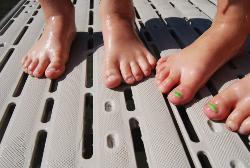
“Flow-Through” Decking
But not just any plastic. Flow-Through decking from ShoreMaster.
It’s also important to understand that not all plastic decking is an actual plastic deck. Some people refer to a composite deck as plastic decking. That is NOT the case.
If the plastic contains wood fibers, it will eventually swell with moisture, despite the fibers being “encapsulated” in plastic. The plastic will wear off the surface and expose the fibers.
You must also understand that there are two basic styles of plastic decking:
1. The “board” style (similar to wood boards); and
2. “open” panels. (perforated panels)
Here’s why that’s important.
The board style has the same problems that wood decking has but without the maintenance required on wood.
The “open” style eliminates the build-up of water on the panels. It self-drains” and cleans itself everytime it rains. It cleans itself without the moisture buildup on the panels. You just have removed one of (3) ingredients for mold and mildew to form.
There are numerous reasons that plastic is the best choice for decking including:
• It’s lightweight;
• Available in many colors and patterns;
• Eliminates the need to clean the decking;
• It can be mounted to the frame with a breakaway clip (recommended) or screwed down;
• It’s cool in the summer heat; and
• Most importantly, it has a 43% open surface.
The open surface allows the water to pass through the decking. These openings relieve the pressure on the dock when a wave hits it, unlike other decks.
In conclusion, if you want the BEST decking for your dock – look for
Flow-Through decking.
Where can you find Flow-Through decking?
At Pier and Waterfront Solutions, of course.
PWS is located at 7325 St. Hwy 42/57. That’s 1 mile North of County MM (Hwy 42) and 3 miles South of Sturgeon Bay. Look for the Idlewild Road intersection. Our staff is ready to assist year round.
Don’t forget – Give us a call If you want to see an issue discussed on our site.
Call Jerry at 920-493-4404 or Email Jerry@wisconsinpws.com with any questions.
Feb 9, 2018
Plastic decking – A GUIDE TO COMPOSITE & PLASTIC DECKING – (Part 3)
Written by ShoreMaster Marketing Updated by Pier & Waterfront Solutions LLC
ShoreMaster offers so many decking choices that it is hard to grasp which option best fits your individual needs.
In this third of three series, we discuss the types of composite and Glacier Flow-Through plastic decking available from ShoreMaster.
Part 1 of this series covered two types of wood decking available. Part 2 covered the latest in aluminum decking and its many options.
How to choose The Right Decking?
Some dock manufacturers are very limited in their decking options. This is a blessing to a dock dealer who wants to limit their on-hand inventory. At the same time, limited decking choices affect your ability to get the best choice for your needs.
With ShoreMaster decking you are not limited to one or two choices. or the few choices the dealer chooses to offer you.
Pier Waterfront Solutions LLC has the widest range of decking choices anywhere. This is a major plus for you as a dock owner.
Decking represents 25% – 50% of the total cost of a dock system
Obviously, the initial cost is an important aspect when choosing decking. No element on any dock system is as important to the user than the decking. Yet, the initial cost is not the only factor you should consider when choosing a long-term dock.
You might be surprised to learn that other factors are important also:
- How you will use your dock;
- How much maintenance are you willing to do yourself versus hiring it out; and
- How long you expect your deck to last.
These answers contribute to the total cost of the decking over the life of the product.
Choosing a Composite or Plastic Decking For Your Dock
Plastic materials are a great decking option for docks. This type of decking may be chosen as a lower maintenance alternative to wood decking despite its initial cost.
One advantage that composite decking has over wood is that there is no need to sand, stain, or refinish it. However, Composite decking is not maintenance free. Many composite decking contains wood fibers.
Mold and mildew may grow in damp or shady areas of the decking which will then begin to show signs of decay if not cleaned regularly. This is due to moisture wicking into the boards along the wood fibers.
Composite decking is NOT the same as plastic decking
It is important to note that people may lump plastic decking into the composite decking category. True plastic decking is composed of 100% recycled and/or virgin plastic.
Plastic decking eliminates the potential for decay caused by mold or mildew, but can sometimes be prone to expansion in the frames. Manufacturers have adjusted the deck size or mounting requirements to handle this problem.
ShoreMaster does not have Composite Decking which is usually used on home decks for obvious reasons.
The Difference between Composite Decking and Plastic Decking
Plastic decking contains NO organic materials. This type of decking is made out of polypropylene, polyethylene, polyvinyl chloride, or some combination of the three.
Plastic deck boards can be injection molded, rotationally molded or extruded. The panels are lighter than composite boards, and they usually have a shinier appearance. They contain openings of up to 42% of the deck surface to allow water to pass through or run off to avoid “pooling”.
Plastic decking will weather better and require less maintenance than natural woods.
Special attention is required for composite decking manufactured with organic materials as they are more susceptible to decay than true plastic decking. Internal expansion from “wicking” of organic fibers in composite decking results in deck expansion also.
How much maintenance is required?
Composite decking should be washed annually to remove mold or mildew. Do NOT use a power washer to avoid damaging the boards. Hand scrub only. Be sure to use a biodegradable cleaner to prevent damage to the environment.
OTHER CONSIDERATIONS
With composite decking, it’s important to remember that the decking absorbs the sun’s rays and may become warm to the touch on hot days. At times it may actually get uncomfortable to walk on it. The darker the color the hotter it gets. On the flip side, composite decking will generally feel warm on cooler days if the sun is out.
Composite decking can also be a problem on large bodies of water much like a wood deck. When waves beat against the bottom of the decking the dock is more likely to flip over if the decking is bolted to the frames. It needs a way to relieve the pressure.
Plastic decking has a major advantage over all the other types of decking. Because 42% of the decking is “open”, it reduces the pressure when waves hit it versus any other type of decking. Additionally, plastic decking has “clips” to secure it to the frame to prevent wash out.
If the “pressure is so great that the “clips” break, it’s better to lose the panel than damage the frames. Usually, the panels settle to the bottom within 100 feet of the dock and are recoverable. They never float completely away.
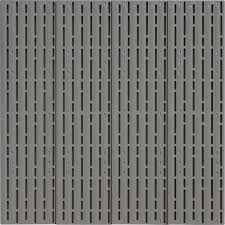
Glacier Decking by ShoreMaster – Grey

Glacier Decking by ShoreMaster – Tan
On the Bay of Green Bay, we have witnessed this happen. An entire steel dock with bolt down decking could not relieve the wave pressure and flipped over in a storm.
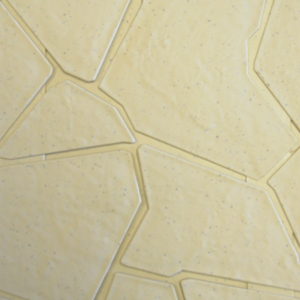
Vertex Decking by ShoreMaster
Next door, a lighter weight, aluminum dock with plastic decking withstood the waves with only an initial loss of a few panels. The next day 95% of the panels were recovered.
Another advantage is that plastic decking does NOT get hot to the touch.
Summary
In general, Glacier Plastic decking from ShoreMaster is really your best option for decking. Plastic decking provides low maintenance and presents long-term durability for your dock application.
Plastic decking advantages include:
- Virtually maintenance free
- Repels the water
- Slip-resistant
- Less pressure on the decking and frames
- Cool to the touch
Remember
ShoreMaster is Your Best Choice for all dock decking choices – no matter what you choose. With eight different decking choices to choose from, you can see why ShoreMaster leads the industry in high-quality decking options.
Now that you have more information on the types of decking options available for your dock system, you’re ready to head to Pier & Waterfront Solutions to see all the ShoreMaster decking options for yourself.
Where are we?
PWS is located in the center of Door County at 7325 St Hwy 57. Located 1 mile North of County MM (Hwy 42) and South of Sturgeon Bay at the intersection of Idlewild Road. Our staff is ready to help you anytime.
Want us to address a dock or boat lift topic for you? Feel free to give us a call.
Call Jerry at 920-493-4404 or email him at Jerry@wisconsinpws.com for more information.



